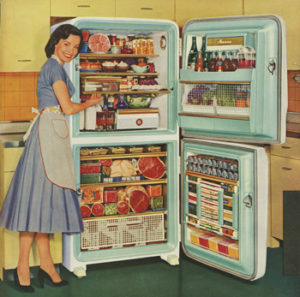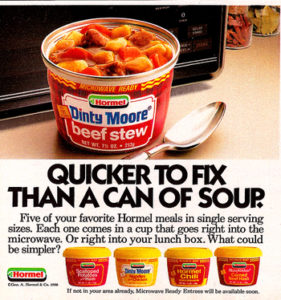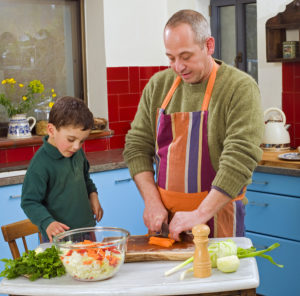7

77
A New Eating Culture
Step into a New Food World
Previous pages have explained that The New Kitchen Way® and Meal Making Transformation are what we’re all about. To that end, my posts and classes share skills, habits, tools, techniques and strategies to turn meal making into something manageable and doable, despite the hectic-ness of our lives. But there’s something more that I hope to inspire beyond the “mechanics” of meal making:
A new culture around food, eating and meal making
By reviving the lost art of making wholesome, satisfying every day meals, I hope to inspire a new view of the kitchen: as the life support center for body and soul. Even deeper than that, my hope is to help create a new kitchen culture, one that allows us to tap into the nurture the kitchen has to offer in our 21st century, high-tech but overwhelmed lives. That’s why the organization behind my programming is a non-profit called “The New Kitchen.”
 I did not start out with these bigger goals in mind, however. My entry into the world of food began 25 years ago as a simple, desperate bid to make wheat- and dairy-free meals for my children. They were quite ill and dairy and gluten allergies were the problem. I only wanted to make them well.
I did not start out with these bigger goals in mind, however. My entry into the world of food began 25 years ago as a simple, desperate bid to make wheat- and dairy-free meals for my children. They were quite ill and dairy and gluten allergies were the problem. I only wanted to make them well.
But magic happened as I was able to heal them by the simple means of herbal remedies and a clean diet. I discovered that food isn’t just something to gobble down to stop feeling hungry. It is powerful “medicine,” capable of both healing us and keeping us healthy.
Over time I came to discover that food–and the kitchen–could benefit me on many other levels, too. Eating meals prepared with care created deep bonds in my family. It brought friends and community members together around my table. Buying foods locally supported our farm economy. And conscious attention to the environmental impact of competing food products allowed me to contribute to the health of the planet.
Far from being an onerous journey of deprivation and sacrifice, the “enlightenment” I achieved by way of my taste buds was a delightfully delicious adventure! I contentedly dined my way deeper and deeper, uncovering fascinating layer upon layer: the comforting power of meals, the vibrancy of vegetables, the unparalleled pleasure of tree-ripened fruits, the nutty and toothsome flavor of whole grains–and ultimately the surprisingly inspired, creative and engaging side everyday meal making.
Of course I wanted to share this amazing healing modality with others. Why shouldn’t we all have access to this really affordable, highly effective discovery and enjoy the wonderful health that it brings? To this end, I developed a number of products and services: a meal management software program, healthy kitchen organization book, educational blog and newsletter, countless recipes, classes and workshops, and private coaching packages.
The Problem: “Kitchen Reluctance”
All of these offerings were aimed at sharing time-saving tools, skills and resources so busy people could access the wonderful elixir of “healthy eating” despite the busy-ness of their lives. While all were helpful, something was still missing.
All the tools, tips, tricks and techniques in the world cannot help us tap into the nurture the kitchen if we have some kind of “kitchen reluctance” that keeps us from spending time in that part of the house.
Put another way, if the kitchen isn’t a place where we’re willing to spend time, we won’t be able to access its nurture, regardless of how many easy, quick and time-saving methods I share. We won’t go there, or if we do it will be with reluctance and a desire to get out as quickly as we can. Either way, we’ll be blocked from accessing the kitchen’s goodness. Hence the need for a new kitchen culture.
Conquering Kitchen Reluctance

I define “kitchen culture” as the combination of skills, perspectives, knowledge, wisdom and attitudes we bring to meal making and the kitchen. I’m advocating for a new one is because, in a nutshell, the old one isn’t working for the 21st century.
We face serious challenges around food–from the degradation of our health stemming from poor eating habits to the environmental destruction resulting from chemically-based agriculture and everything in between. Book after book and film and film has documented the sad state of our food world.
There are many reasons for this decline and many solutions will be required to remedy it. One solution that must be included, however, is making our own meals.
Much as we might wish and hope otherwise, good nutrition can’t be bought in a microwaveable box. Nor can we save our environment, communities and local economies if we are dependent on meals in boxes. Although there are a few exceptions, the only way to get the kind of meals that will save people and planet is by making them ourselves with real, whole, sustainably grown foods. That, in turn, means spending some time in the kitchen.
This solution, of course, runs us smack dab into the “kitchen reluctance” problem. By and large, our culture says the kitchen is old-fashioned and frumpy and we have far better things to do with our precious minutes than spend time on the enormously time-consuming act of “cooking.”
Many, many people have bought into this line of thinking. In fact, it has become a common assumption adopted and believed without question. But given the state of our health, it deserves some questioning. Can you see how, if you buy this line of thinking, you’ll be locked out of the kitchen, incapable of realizing the benefits of good food and contributing to a better food world? This is why, if we are to save our own health and that of the planet, we need a new kitchen culture capable of freeing us from “kitchen reluctance.”
What Does a New Kitchen Culture Look Like?
This brave new culture will say it’s OK to spend time in the kitchen. Cooking and food will be unquestionably valued, respected and worthy parts of our lives that deserve some of our precious time and attention. And there will be no doubting that we deserve the gifts of health, comfort and refreshment that come from preparing and enjoying real, whole, nourishing food.
When phrased this way, you might wonder, “How could this kind of thinking not be a part of our culture?” I make a new kitchen culture sound like some radically novel idea. But actually, doesn’t it just make total sense?
As human beings, the single most important thing we must do for the survival of the species is to keep our bodies alive–and not just alive but functioning at the optimal level required to capably face all the mighty challenges of living on this earth. In turn, feeding ourselves well is the single most important thing we must do to keep our bodies alive and functioning at an optimal level.
Absurdly, however, our advancements over the centuries have distanced us ever further and further from this fundamental requirement for the continuation of the species. We have come to live as if we needn’t care or worry about the food that is the very foundation of the fantastic lives we lead–as if we could sustain ourselves by breathing and bathing in technology!
Falling Into a Culture Void
A good question is, “How did we end up so far astray from the foundations and fundamentals of our very existence?” Another good one is, “How did we end up in a food culture that disdains the common, ordinary act of feeding ourselves healthfully, day in and day out?”
While there are surely a number of reasons, part of the answer lies in changes to the social order that came about when women entered the workforce en masse, leaving behind their roles as housewives and caregivers. With this development, changes to kitchen culture were necessary and inevitable.
Nevertheless, we probably could have survived the changes sparked by this social shift–and created a culture that better served the new social order. But at the very same time, the food manufacturing industry initiated a massive marketing effort aimed at promoting packaged foods over real, whole foods that required home preparation.
This was the death knell for a kitchen culture that celebrated and valued wholesome and home-prepared food. In its place, the food industry enshrined time-saving convenience and low cost as the dominant values in our food culture. All other values were diminished or dismissed. The consequences have been devastating and life-destroying on many levels.
Piecing Together the Past
It’s important to acknowledge that our food culture did not always look like it does today. Not so very long ago, there was a time when food and meal making were just normal, natural parts of life that were valued the same as every other part of life.
That culture, as I remember from living through it, is represented by June Cleaver on Leave It To Beaver. Granted, June’s kitchen culture could be described as suffocating, rigid, and unfairly stereotypical. More on that later. But for those raised in the 50s and 60s, June’s world might be remembered as the embodiment of the ideal around meal making and meal times.

Promptly at 5:00, husband Ward would walk in the door to a delicious (even if boring) home-cooked dinner, prepared lovingly by June. June’s two lovely children, Beaver and Wally, would be scrubbed and eager to sit down for a family meal.
From this TV ideal certain kitchen norms coalesced (that I remember from my family’s meal times, too.) Meal making was a woman’s job; dinner needed to be on the table by 5:00, no later than 5:30 p.m.; the table had to be set and everyone seated at the appointed hour; dinners had a meat, starch and vegetable; dinnertime was calm family time, punctuated only by polite conversation; smiles all around were expected; kitchens were kept spotless and dirty dishes weren’t left to fester on the kitchen counters; and above all, the meal needed to be something that dad liked.
The Leave It to Beaver kitchen culture was comforting and beneficial in some ways, but as mentioned earlier, it was also suffocatingly stereotypical and rigid. In fact, that rigidity is what destined it for failure. With all the social, and eventually technological, upheaval that followed the 50s and 60s, flexibility was needed for the survival of the valuable institution of wholesome, sit-down meals. But our kitchen culture didn’t flex.
So we threw that out! And with no regrets. Besides being rigid, it was unrealistic and not very fun. Not to mention, it really malfunctioned when June started working outside the home. In fact, for we feminists of the 70s and 80s, our distance from the kitchen became a badge of honor. Nobody was going to chain us to the stove!
The problem is that after throwing out the Cleaver culture, we never created or installed a good replacement. Probably because we were all too busy with work outside the home piled on top of work at home!
To be sure, there were a couple attempts to update the model, both unsuccessful. In the 70s, television ads cheered women on, assuring them that they could “Bring Home the Bacon and Cook It Too.” While a clever campaign, the underlying premise was flawed: No one gave women the 26-hour day needed to both bring home and cook the bacon!
The 80s and 90s brought relief in the form of takeout, expanded deli sections, bargain restaurants and fast foods. However, given the current 66% obesity rate along with the frightening increase in diet-related diseases, among many other serious consequences, that model hasn’t proven itself to be a workable substitute either.
Enter the Food Marketers
Coinciding with women’s entry into the workforce, the food industry launched “a massive campaign against traditional cooking” beginning in the 1950s.** In Something from the Oven, food historian Laura Shapiro recounts how the industry took aim at home cooking after World War II,
rapturously envisioning a day when virtually all contact between the cook and the raw making of dinner would be obsolete. By the 1950s, magazines and newspapers were conjuring scenes in which traditional, kitchen-centered home life was being carried out in perfectly delightful fashion without a trace of traditional, kitchen-centered home cooking.
Why was the food industry taking aim at home cooking? Factory-made food, of course, was the intended beneficiary of this campaign to discredit cooking as old-fashioned, un-hygienic and needlessly laborious. With the war over,
the food industry found itself confronted with the most daunting challenge in its history: to create a peacetime market for wartime foods. . . . [A] great deal of new technology was in place or under development and factories were ready to keep right on canning, freezing, and dehydrating food. . . . What the industry had to do was persuade millions of Americans to develop a lasting taste for meals that were a lot like field rations.
Interestingly, Shapiro found that women did not immediately rush headlong into the waiting arms of the prepared-food industry. They resisted for many years. “Cooking, it turned out, had roots so deep and stubborn that even the mighty fist of the food industry couldn’t yank all of them up.”
To the chagrin of food marketers, “no independent research backed up the vision of the homemaker who ‘loathed’ making dinner. In fact, the overwhelming consensus of scholars . . . was that women liked cooking better than any other household task.” In one study, 95 percent expressed positive feelings about cooking. What’s more, most women had no trouble “finding enough time to produce a typically unadorned American meal for their families,” and they “rarely complained that cooking took too much time.”
In the end, as we know, the food marketers cracked this nut.
Consumer Psychology Cracks the Nut
Using the new science of consumer psychology, they explored the “mysterious and ineffable forces” restraining homemakers from wholeheartedly embracing convenient, easy to use prepared foods. They discovered that there was a moral dimension to preparing food for one’s family. There was also “the personal dimension, the hospitality, the sense of a gift from the heart and hands that had characterized the notion of home cooking for millennia.” Far from being loathsome, one columnist remarked that cooking is “really a creative job and one that’s particularly rewarding.”
In other words, our food culture valued making meals that nurtured and nourished.

Once food marketers understood the deeper and more complex underpinnings of our food culture, they were positioned to undermine and supplant it. Given women’s “stubborn and insensible” affinity for cooking with only limited reliance on convenience products, marketers figured their only course of action was to overhaul our whole view of what it means to “cook.” They created a new view of cooking that included the frequent and unabashed use of convenience foods and then set about to embed that view firmly into our food culture, replacing earlier versions of what women deemed acceptable in terms of cooking.
Cooking Gets a “Modern” Makeover
The first step in this process was to “dismiss as outmoded any chore more laborious than applying a finishing touch [to prepared food.]” Women were bombarded by marketing messages and articles that contrasted the food industry’s modern version of cooking with “its old-fashioned counterpart, which was always depicted as a task of staggering dimensions.” (But Shapiro noted that this “counterpart” was usually cooking as it existed prior to the conveniences of the 20th century. In point of fact, women of the 50s spent about five to six hours less on meal making in the 50s compared to the 20s; 17 to 18 hours vs. 23 hours.)
The second step in the re-culturing process was a relentless effort to convince women that they actually did not have time to cook, despite their beliefs otherwise, as noted above. Advertisements and stories plowed across the media reminding readers again and again how busy they were, how frantic their days, how desperately they needed products and recipes for quick meals.

Oddly emblematic of this theme was Kellogg’s insistence that “what mothers really liked about the new Corn Pops was that the cereal was pre-sweetened, a boon they found to a be a great time-saver.”
It was only a matter of time before the packaged food industry won the war. It’s sway over the media allowed it to hammer housewives with its new view of convenience-driven meal making, which led eventually to its acceptance–and the beginning of a long, slippery slope away from respect for making our own meals from real, whole, unadulterated foods.
Losing Our Food Soul
Now, several decades later, we find ourselves in a crazy place. Despite the absolutely vital role that food plays in our survival, we have been led to believe–and have acquiesced in the belief–that the most we need to know about food is which brand of frozen pizza is the cheesy-est, what kind of soup is the thickest and chunkiest, and how to choose the cheapest brand of ketchup.
We’ve bought in to the industry’s position that we need not fritter our time away learning about what’s in our food and where it comes from and its true nutritional value. We’ve implicitly agreed to simply place our trust in manufacturers and grocers and rely on whatever they see fit to put on the grocery store shelves.
Of course that was a spectacularly bad move.
Corporations up and down the food chain are driven by one motive: shareholder value, i.e., profits. They are not the guardians of our health and absolutely cannot be trusted to protect our health interests. Although it would be nice if food companies had consumer health as a top priority, that happens only rarely. For the most part, minding our health is our job and ours alone–and the key to successfully doing our job lies in heading to the kitchen to make our own meals from real, whole, sustainably grown foods.
Re-Creating Our Kitchen Culture
So now we’re back to the need for a new kitchen culture that will support our return to the kitchen. In this undertaking, corporate food marketers must obviously be stripped of any role. Instead, creating a new kitchen culture is something only we can do. While a big job, it is also both exciting–and empowering.
First we need to realize that our current kitchen culture is largely just a fabrication of the food industry, deployed only to sell us their packaged foods. It is little more than a myth, a false construct–a something we can completely ignore.
Second, in place of that false culture we are free to create our own version that meets the needs, hopes and desires of today’s world! And we don’t need any governmental order or other kind of authorization to do so. A new culture arises very simply, as each of us makes a conscious choice to form a new, more meaningful and helpful relationship with food, the kitchen and meal making.
Over time, our individual actions come together, common assumptions and norms shift and a new culture is born. We see things differently and have permission to act bravely in ways that better serve us and our health.
Creating a new culture is obviously not a one-person job! By definition, we all contribute–and I hope you’ll weigh in below in the Comments section. To get the ball rolling, however, I’ve identified some possible aspects of a new culture based on my many years in the field. I believe that if these aspects were part of our common assumptions, meal making would happen much more easily and successfully–and we would be able to reap the many health and other benefits that flow from eating nurturing, real and whole food meals.
Mapping a New Kitchen Culture
Flexibility

Flexibility is a key part of a new kitchen culture. Meal making and mealtimes happen in widely varying circumstances, from single parents and single people to big families and couples; from night shifts and multiple schedules to ethnic tastes and traditional tastes; from working moms and stay-at-home dads to road warriors and home office employees; and from kitchen newbies to veterans. Whatever our wildly divergent situations, we all need to nourish our bodies. So what’s accepted and valued as meal making needs to be big enough and flexible enough to accommodate everyone.
Respect
At the same time, the core value of respect for food would tie us together despite our varying circumstances. Respect is needed all up and down the food chain, for farmers who forego air conditioned offices to grow food, immigrants who break their backs harvesting it, grocers willing to stock healthier but non-mainstream products, and for the earth itself, which miraculously turns little, dead-looking seeds into luscious and nutritious fruits, vegetables, grains, beans and nuts that make it possible for us to live at all.
And of course, we must renew respect for everyday meal making. Making meals is about as low on the totem pole as a chore can go (although interestingly, it topped the totem pole in the food culture of the 50s!) Food itself is one of the least valued of our purchases. We get indignant about spending a mere 11% of our disposable income to keep ourselves from starving. (Consumers in other countries spend far more.) And where do we buy food? In department stores like Target and Wal-Mart, where it is sold like TVs, Nike® knockoffs and every other mass merchandise product.
As we come to truly value and honor the vital role of food in our lives, we’ll find that a lot of eating-related problems iron themselves out naturally. For instance, as making and eating nourishing meals becomes solidly embedded as a core value, we may be surprised to find that the time to make those meals becomes available, even if our lives stay as busy as ever. Reshuffling our values works a sort of magical reshuffling of our time.
Self-Reliance

If we want to re-take control of our health, free ourselves from an ever-escalating need for more drugs and surgical procedures, save the planet from food-related pollution and carbon emissions, and eliminate the landfill waste created by the convenience food industry, then becoming more self-reliant is a must.
It’s hard to thumb our noses at McDonalds, Wendy’s and Dominos if we can’t boil an egg to save our lives. So valuing food and the kitchen must be accompanied by taking action to re-skill and acquire the basic kitchen know-how to capably make our own meals from real, whole foods.
As it now stands, kitchen know-how has been largely relegated to the antiquities shelf of the library–something of historical, but little current value. Why should we bother with all the details of food-making when hundreds of restaurants, delis, packaged foods companies, and takeout services are ready to easily and conveniently meet our everyday food needs?
The answer to that question is obvious and only becomes more obvious by the day: because our love affair with convenience is killing us. What’s more, convenience foods are very often manufactured from commodity crops that depend on environmentally suicidal growing, manufacturing and transport practices. Convenience products produce enormous amounts of plastic and paper waste. Finally, they divert valuable farm resources from the health-giving foods we desperately need.
It’s understandable that we ignore these realities because convenience foods are so, well, convenient! And with our crazy-busy lives it’s hard to imagine keeping hunger at bay without cheap subs, pizzas, deli chicken and Chinese takeout.
Which is precisely the point. We’re trapped. Absent a greater self-reliance, we can save neither ourselves nor our planet, communities and local economies.
Admittedly, many of us are a long way from that end, but just start taking steps. Over time–and not a very long time at that–you’ll learn to transform the fruits of the earth into palatable meals without needing a factory in between. Take heart that people have done this for millennia with far less technology and far fewer conveniences than we have today.
Note, too, that making decent, nourishing meals doesn’t require gourmet cooking or even much cooking at all. It is enough to simply turn real foods into meals that satisfy your taste buds and nutritional needs. Don’t be bullied into thinking that more is required of you.
Mastery, Engagement–and Sparkle

The funny thing is, re-acquainting ourselves with the food world isn’t as old-fashioned or dowdy as the food industry would have us believe. Delving into the food world’s vast repository of culinary wisdom and know-how is actually very engaging. It leads to a sense of mastery that is surprisingly satisfying, on subjects both small and large, from how to cook tough meats, preserve food and use every part of a vegetable to selecting a good winter pear, knowing what herbs and spices go with what foods and understanding how to cook grains and beans.
Bottom line: Re-engaging with the kitchen and meal making can add a strangely delightful sparkle to our food lives. And our new kitchen culture should absolutely include fun and enjoyment!
Radical Eating
At the outset of my healthy eating journey I, like most people at the time, believed that food was simply for filling a hungry stomach and tasting good to my taste buds. It had nothing to do with curing or preventing illness. That’s what pills were for.
Our thinking has changed dramatically over the ensuing 25 years. Now, “you are what you eat” is a refrain so common it’s almost trite.
Yet all too often that refrain stays stuck in the realm of talk, never graduating to the realm of action. And when push comes to shove, that talk will readily fly out the window if it’s 2:00 in the afternoon and we’re dying for a sugary soda, or when friends are gathered after work around a tempting plate of mozzarella sticks, or when we’re tired after work and can’t work up a little energy to cook the vegetables rotting in the frig.
The state of our health is far beyond mouthing platitudes about how “food is the best medicine.” We need radical improvements in our meal making and eating habits if we are to survive as a responsible, productive, caring population capable of creating a peaceful, sustainable world.
That’s harsh, I know. But remember that to date, our food culture has been dictated by the food industry. Its objective has been to lull you into believing that an occasional salad and a few pieces of fruit will redeem you from an otherwise life-destroying diet of processed, refined and packaged foods.
Now that we have dethroned the propaganda behind the food industry’s destructive culture, it’s time to get real. And the reality is that we need to make radical changes to the way we eat–not all at once, but promptly. Step by step, diligently and persistently, start eating like it really matters, because it does!
Courageous Nutrition
So how do we know what to eat that’s good for us?
This is where courage comes in. We have come to rely on experts in white lab coats to tell us what to eat. That has created countless competing dietary approaches that often contradict each other. It has also spawned dozens of food fads and trends from experts insisting that this food or that is critical to our good health. All of this has have left us confused and bewildered–to the point where it’s easy to just give up and eat whatever.
What if we had the courage to simply eat in the way nature intended?

A new kitchen culture recognizes that, as I put it, “Healthy eating is easier than you think.” By following the “Real, Whole Food” eating approach we can, for the most part, figure out and eat a good diet without getting mired down or waylaid by competing expert opinions and the latest food fads.
It’s simple: If you ever wonder whether something is fit to be taken into your body, ask if it is real and whole, i.e., does it come directly from the ground, from an animal that ate only foods from the ground, or is it made entirely of foods that come directly from the ground with the least amount of processing required to make them edible.
Think of this as “eating low on the food chain.”
Once you begin eating right for yourself, you can use your food choices to power improvements in our communities, local economies and environment. Gravitate towards real, whole foods that are organically and sustainably grown and you support better air, water and soil. After all, how healthy can you be if the air you breathe and water you drink is polluted? Protect and nurture the earth and the earth can do a better job protecting and nurturing us.
And as we head into a seriously carbon-constrained world, it also makes sense to gravitate towards foods grown closer and closer to home. Begin now to support a local infrastructure of farms, food producers and distribution systems. Not only is this wise in terms of the environment–you stand to be rewarded with some spectacularly tasty food!
Food As Friend
Are we about done with eating as the enemy? I’m ready for women to look at a plate of food with joy and delight instead of apprehension and visions of lard landing on their middle parts. Hasn’t feminism advanced enough to encompass eating honestly and openly, without buckling under the glare of the weight-loss gods?
Be thankful, men, that you are not burdened by this relic of the 50s (carefully cultivated by the media so it is just as virulent today.) May we women be blessed with new eyesight to see food just for what it is: vital nourishment for our bodies. And yes, it does contain calories. That’s the point. Calories are what keeps us alive!

The Kitchen as Oasis of Comfort and Community
In a new kitchen culture, the kitchen isn’t a room that has outlived its usefulness (some people brag that they don’t even need a kitchen anymore.) Nor is it a place of drudgery, toil and aggravation. Nor just a designer showcase that we are loathe to dirty with meal making.
A new kitchen is a friendly, inviting, nurturing, comforting, working, breathing, and very much alive part of our homes and lives. It’s the place where we go to make the meals that are the foundation for all those other parts of our lives that are deemed really important: careers, jobs, business deals, shopping trips, vacations, social events, degrees, marketing campaigns, etc. None can happen–and certainly not optimally–without nourished people to do them.
Fun
Much as I treasure the family meals of my youth, I must admit they were fairly tense affairs-largely because things were so structured and rigid.

In a new kitchen culture, mealtimes are fun times, something we look forward to at the end of the day, times to reconnect with family members, maybe also friends or housemates. It doesn’t matter that somebody forgot to bring ketchup to the table, or that somebody is a little late, or somebody has to leave early. The main thing lies in enjoying our food and each other’s company as much as possible, and feeling like you’ve just had a refreshing break from the day.
Cooking Is Not a Competitive Sport
Finally, with all due respect for the food competitions that have become popular these days, cooking is not a competitive spectator sport. Food wasn’t meant to be better or best, just good, nourishing, appetizing and pleasurable. There is no such thing as loser dishes–or cooks.
The Power We Hold
Wow–does that sound like a lot? It is–because lot goes in to creating a new culture, especially if we do it consciously instead of just letting it happen to us–as has been the case for the past several decades.
Yet the results are so worthwhile! Imagine a world where most of us make vegetable-rich meals with wholesome, real, local foods that are both sustainably grown and produced in a way that fairly compensates each person in the chain of production. Those meals are self-prepared so they are economical and optimize healing and nutritional values. And those meals taste really good and are eaten with relish, pleasure, relaxation and good conversation. Imagine the good that would come tumbling forth:
- fewer illnesses and chronic diseases and the downtime that goes with them
- far fewer expensive drugs and procedures (and their side effects)
- more mealtime satisfaction, leading to less overeating
- friendlier relationships with food, leading to less disordered eating and counterproductive “dieting”
- valuable stress relief (one of our biggest and most powerful health deterrents we face)
- greater productivity and energy at home and office
- more time to talk and build relationships between family members (especially teens)
- automatic reductions in inactive screen time
- more exercise and activity while making meals, cleaning, shopping, etc.
- greater food affordability (due to fewer packaged and restaurant meals)
- healthier air and water from reduced pesticide and fertilizer usage
- fewer carbon emissions (from shorter transports, reduced meat consumption, etc.)
Did you ever think that the ordinary act of making and eating a meal could have such powerful effects? It sounds like a lot for the humble kitchen to accomplish but it is absolutely possible.
How You Can Contribute to a New Kitchen Culture
We can contribute to building this kind of wonderful new kitchen culture every day, for example each time you:
- Take the leap and pay an extra 50 cents for an organic rather than a conventional pepper
- Take time to find a food product with the least amount of packaging and either no or the fewest additives
- Say “No” to an ad insisting that you have more important things to do than make a nourishing meal
- Say “Yes” to gifting yourself 30 minutes for preparing real, whole foods
- Stop long enough to pull out and use a vegetable or two from the frig before they rot
- Get radical and try a new spice that delights your taste buds and connects you to the joy of making good food
- Steel yourself against body-hate messages that drive you to any kind of unnatural eating
- Take a few extra minutes to figure out how to use up, rather than toss out leftover dishes and foods
- Take a minute or two to compost vegetable scraps instead of throwing them in the trash
- Avoid the temptation to buy blueberries and strawberries shipped from overseas to tempt our winter-weary taste buds
Once started, you’ll see the power you hold: Three times a day, seven days a week, with every meal you make, you have the opportunity to create a new kitchen culture that vastly improves life on earth.
I hope you’ll join me to make it happen.
- Start by adding your comments below about kitchen culture–did you ever consider it before now? How would you describe your current norms and beliefs around food and cooking? What kind of a culture would you like to see?
- Get started on becoming self-reliant and tapping into the joys the kitchen has to offer. Our 3 FREE Tools will get you going.
- Join one of our classes and learn how to become KitchenSmart® so you can lower–and even eliminate– any kitchen blockages that stand between you and real whole food meals.
- Join our newsletter for more educational article series, recipes, webinars and podcasts.
- And of course, read and learn more with the posts on my blog.
To a Happy and Healthy Kitchen Culture
ff
**All quotations are from Something from the Oven, Reinventing Dinner in 1950s America, Laura Shapiro, Viking, 2004, pp. xix, xx, xxiv, 44-46, 52, 53, 55, 61, 62
***Picture Quotation: “‘No Place For Discontent’: A History Of The Family Dinner In America,” Mackensie Griffen, NPR The Salt, February 16, 2016: https://www.npr.org/sections/thesalt/2016/02/16/459693979/no-place-for-discontent-a-history-of-the-family-dinner-in-america

You’ve done it! You’ve catured the exact idea(s) I’ve been reflecting on and forming over the past few years…I want to capture these thoughts and share them widely…I want to sit in hundreds of kitchens and get the personal stories/perspectives/insights that link each of us and our kitchen relationships. Then, I want to record and speak to large groups about how each of us can connect to the whole and reshape our kitchen culture. And all along, I’d thought I made up the term “kitchen culture” for my own internal musings about this movement that must be embraced and perpetuated. So glad to read your affirming words. I’m very impressed with both your writing style and the content you present. We need a team/network of Kitchen Goddesses to educate and inspire…every region to start with! No competition…just collaboration toward a common mission with respect for unique approaches to the same concepts. Thanks for taking the time…people ARE interested in these ideas.
Heather Diamond
Tallahassee, Florida
We’ve been calling it getting in touch with your inner kitchen but it amounts to what you’re talking about – love the concept of kitchen culture and the “dahla.” I agree with the comment above – we need a team of kitchen goddesses (or divas!).
Trying to get my clients to understand how important this center of the home is to the quality of their lives is difficult at times! It often is relegated to the bottom of the list of priorities they want to accomplish in my surveys. We need more of this – thank you!
Where, when, how to move it forward!?! How to make it tangible for people locally? There is a package of concepts that this belongs to: simplicity, minimalism, natural birth and parenting, natural healing, localism/community…so many degrees of each…so much value in taking responsibility for our bodies and what goes into them…Recently I heard a friend say to her son when she was explaining why he shouldn’t watch television, “The two most important decisions you make every day are what to put into your head and what to put into your body.” Kitchen as the center of the home is a foundation! I want to stay in touch with my “inner kitchen” and am glad others are generating energy around the idea.
This is so exciting! I just read about the New Kitchen Culture and found it fantastic. Another way we’ve lost our comforting kitchen culture is by losing our kitchen tables. That’s because too many houses don’t have room in the kitchen for a kitchen table. You likely point that out somewhere.
Loved reading this article and LOVE the concept of changing the Kitchen Culture!! I too have found myself STUCK and bought into the media BS about not having “time” for cooking!! I too have found myself saying: “It’s not my JOB to cook all the meals!” “I have a full (+) time Job, too ya know!” I have recently found that I really enjoy cooking good meals and LOVE it when I see my husband pick up his plate and LICK it CLEAN!!! (LOL, he really does do this!!) I have come to appreciate this as a LOVING ACTION – as he’s showing me how delicious he thought the meal was!!! AND IT MAKES ME FEEL LIKE I ACCOMPLISHED SOMETHING JUST FOR HIM!!! I’m SO excited to take this journey and REALLY dive in and BECOME the NEW KITCHEN CULTURE for him (as the kids have all left the nest) and Myself!! I’ve been struggling with losing the extra pounds that have come on since I “Drank the Koolaid” (meaning buying into the idea that I didn’t have the time!) I’m throwing OUT the Koolaid!!! Thank you for this article and helping me see there is a way to make GOOD and HEALTHY meals in a short period of time (20-30 minutes)!! Who doesn’t have that time – and as I think about it, it takes about the same time – if not longer – to go out-to-eat, or go out to a fast food restaurant to get something to eat! So Why not make the meal MYSELF!!!
I love the way you teach! My family didn’t teach me many cooking skills. I often look at each recipe as stand alone. I will learn so much from you and my family will benefit immensely.
That’s so great to hear Jackie. A lot of people never learned many cooking skills growing up–and it’s easy to feel intimidated. My hope is to share simple blueprints that you can learn once then then use again and again. I’ll send the Italian, Curry and Cuban versions to get you started and you’ll sson be making up your own creations! Keep us posted!